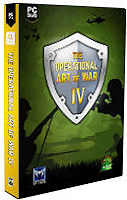 The Operational Art of War IV includes a suite of new naval features that should prove to be a good first step towards a full naval warfare model.
The Operational Art of War IV includes a suite of new naval features that should prove to be a good first step towards a full naval warfare model.
Naval Combat: To recap, naval combat in TOAW had been very crudely modeled. Ships were literally treated as if they were a single piece of equipment – like a single squad. Any AP hit killed them. Their defense strengths weren’t used in that determination, by the way. This surprising discovery meant that it was as easy to sink a Battleship as it was to sink a Destroyer. AP strengths were combined for hit determination – making a bunch of DDs as powerful as BBs. Whether hit ships were permanently destroyed or just sent to the “On Hand” pool bizarrely depended upon a check against their proficiency. Fleet units could “evaporate” like a land unit that had lost cohesion. Embarked units employed their various strengths when attacked. The whole thing had to be overhauled if there was to be any hope of realistic naval warfare. It has been. The new naval combat model has the following features:
- Ships now have damage levels, and take damage in combat, if hit by the attacking ordinance. Those levels are displayed in the unit report.
- Attacking equipment Anti-ship factors are evaluated as individual shots/planes so that each warhead can be evaluated for armor penetration.
- Hit chances depend on a number of checks made involving various factors such as the visibility, attacker proficiency, target agility, aircraft anti-naval strength, gunnery range, and shock levels.
- The amount of damage a hit inflicts on a target ship depends upon shell weights of the ordinance hitting them, their armor thickness, and their durability.
- Ship armor and durability are derived from the ship’s defense strength, unless the designer has explicitly specified them using the new naval equipment add-on to the scenario’s equipment file. That file also allows ship agility, accuracy, and speed to be explicitly specified.
- Embarked units’ armor, durability, agility, and AAA are fixed at 0, 25, 18, and 0, respectively. This means that the strengths of the embarked equipment are no longer used to resolve attacks on embarked units.
- Ships that accumulate 100 or more damage points are eliminated – sent to the dead pile.
- Ship damage levels less than 100 are saved in the unit on each TO&E line. Those levels debilitate the ship’s AP, AAA, Speed, Nuclear Strength, and Agility accordingly. They do not affect Defense Strength, Armor, or Durability levels. Damage levels of 50 or more turn the ship’s TO&E button silver (for a bit of chrome).
- If a TO&E line contains more than one ship all damage on that line is applied to only a single ship until the damage totals 100 – at which point one ship is sunk and the damage level of the TO&E line drops back to zero. Call it the “lead” ship in that line. Other ships in that TO&E line remain undamaged (and invulnerable) – until they become the “lead” ship due to the sinking of the previous one. Note that there is a technique available to designers to split such multiple-ship lines up into single ship lines, if desired.
- Naval units cannot be disbanded by players or evaporated by combat short of all ships in the unit being sunk. Combat never sends ships to the “On Hand” pool.
- Aircraft Carriers with more than 66 damage points cease to function as aircraft carriers. If that means that there are then fewer aircraft carrier bases than air units in the hex, one air unit will be eliminated.
- Carrier-based air units are exempt from combat reorganization.
- Damage points incurred by embarked units destroy a weight of equipment equal to those damage points.
- There is limited ability to repair some damage while at sea and significantly more while at port.
This new combat procedure only affects combat where the target is a ship or embarked. Bombardment of land units by naval forces is still resolved just as it has always been resolved.
Read the full entry here.
Check out the official The Operational Art of War IV product page for more game information!

